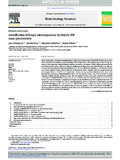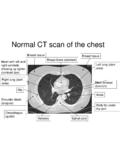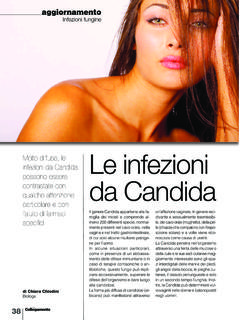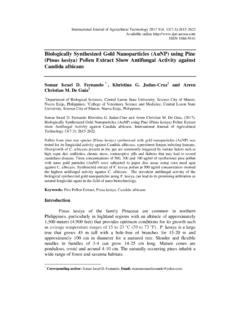Transcription of Treatment of vaginitis caused by Candida glabrata
1 Treatment of vaginitis caused byCandida glabrata :Use of topical boric acid and flucytosineJack D. Sobel, MD,aWalter Chaim, MD,bViji Nagappan, MD,aand Deborah Leaman, RN, BSNaDetroit, Mich, and Beer Sheva, IsraelOBJECTIVE:The purpose of this study was to review the Treatment outcome and safety of topical therapy withboric acid and flucytosine in women withCandida DESIGN:This was a retrospective review of case records of 141 women with positive vaginal culturesofC glabrataat two sites, Wayne State University School of Medicine and Ben Gurion :The boric acid regimen, 600 mg daily for 2 to 3 weeks, achieved clinical and mycologic success in47 of 73 symptomatic women (64%) in Detroit and 27 of 38 symptomatic women (71%) in Beer Sheba.
2 Noadvantage was observed in extending therapy for 14 to 21 days. Topical flucytosine cream administered nightlyfor 14 days was associated with a successful outcome in 27 of 30 of women (90%) whose condition had failedto respond to boric acid and azole therapy. Local side effects were uncommon with both :Topical boric acid and flucytosine are useful additions to therapy for women with azole-refractoryC glabratavaginitis. (Am J Obstet Gynecol 2003;189:1297-300.)Key words: vaginitis , Candida glabrata , boric acid, flucytosineThe increased use of vaginal cultures in the treatmentof women with chronic recurrent or relapsing vaginitis hasprovided clinicians with new insights into theCandidamicroorganisms that are responsible for yeast attention has been directed at nonalbicansCandidaspecies with regard to epidemiologic makeup, clini-cal manifestations, diagnosis, and Treatment of suggestions of a significant trend to increasedoccurrence of nonalbicansCandidainfection,4morerecent studies have failed to confirm an ,7 The most common nonalbicansCandidaspecies reported isCandida glabrata .
3 Which has attractedattention because of it is known to reduce in vitrosusceptibility to the entire class of azoles and polyeneantifungal , in spite of the increased awareness ofvaginitis caused byC glabrata , cases are still too infrequent,especially at a single site, to permit the performance ofa randomized prospective controlled study to establishoptimal Treatment . Even multicenter studies have notbeen forthcoming. Moreover, the numbers of women whoare infected withC glabrataand who are enrolled inCandidavaginitis studies have been insufficient to allowseparate ,7 Accordingly, practitioners havebeen provided with relatively poor information regardingtreatment effectiveness, which is tainted further byaccrual bias.
4 In 1994, we reviewed our experience with40 women who were infected withC glabrata , some ofwhom were treated successfully with topical boric no new information has been published sub-sequently, we reviewed the Treatment outcomes with boricacid in 141 additional women at two geographic sites withdiffering patient demographics and report, for the firsttime, the effectiveness of flucytosine in women whosecondition failed to respond to boric acid retrospectively reviewed the medical records of allpatients, from whomC glabratawas isolated from vaginalswabs, who were seen at the Wayne State UniversityVaginitis Clinic between 1992 and 2001. Before recordreview, approval was obtained from the Wayne StateUniversity Investigational Review Board.
5 In addition, oneauthor (W. C.) reviewed case records (n = 39) of womenwithC glabratawho were seen in a private clinic in BeerSheba, Israel (1996-2002). None of the patients who aredescribed in the current study have been records were reviewed for demographic detailsand Treatment courses with boric acid, flucytosine, andother glabratamicroorganisms wereidentified on the basis of negative chlamydospore andgerm-tube formation and carbon assimilation testing withuse of API strips (Sherwood Medical, Plainview, NY).From the Division of Infectious Diseases, Wayne State University Schoolof Medicine,aand the Department of Obstetrics and Gynecology, BenGurion for publication January 28, 2003; revised April 8, 2003;accepted May 30, requests: Jack D.
6 Sobel, MD, Division of Infectious Diseases,Harper Hospital, 3990 John R, Detroit, MI 48201. 2003, Mosby, Inc. All rights $ + 0 (03)00726-91297 Boric acid was available as a gelatin capsule that con-tained 600 mg of boric acid (Professional CompoundingCenters of America) and were administered throughthe vagina once daily for either 14 or 21 days (non-randomized). Flucytosine cream was prepared as de-scribed by Horowitz12and administered as a nightly 5-gintravaginal dose for 14 days. Fourteen 500-mg capsules offlucytosine (Ancobon) were opened into a mortar andreduced to a fine powder. The powder was levigated withglycerin to form a smooth paste. The levigated mixturewas added to a hydrophilic ointment base or cold cream to45 g.
7 This mixture was blended until smooth, and two2-ounce ointment tubes were filled. Medical records wereexamined for documented side and adverse effects. Onlysymptomatic episodes were vitro susceptibility of allC glabrataisolates (Detroit)were determined with the use of the N-27A microdilutionNational Committee for Clinical Laboratory the period between 1994 and 2001, 118 isolates ofC glabratawere obtained on vaginal culture from 102patients at the vaginitis Clinic, Wayne State University. Ofthe 102 patients, 75 women were white, and 23 womenwere black. The age range was 16 to 70 years (medianage, 41 years); 25 patients were older then 50 gynecologic factors were rare without theemergence of selective factors except for a past recenthistory of recurrent bacterial vaginosis (10 patients) andrecent desquamative inflammatory vaginitis (10 patients).
8 Not all patients were symptomatic; 73 symptomatic pa-tients received therapy with boric acid. Forty of the 73patients (55%) who were treated with boric acid werereferred to the clinic because of refractory yeast vaginitis ,after having had failed repeated courses of azole patients were receiving estrogen hormone replace-ment therapy; only 5 patients (5%) had diabetes features during the symptomatic episodes ofCglabratavaginitis were indistinguishable from episodescaused by other species. The median vaginal pH was saline microscopy, budding yeast without hyphalformation were observed in 95 of 118 episode (81%). In73 episodes of symptomatic vaginitis that were treatedwith boric acid, 47 patients had improved symptoms andbecame culture negative (64%), 23 patients remainedculture positive with residual symptoms (32%), and 3patients were lost to follow-up.
9 No difference in outcomewas found when patients who were treated for 14 and 21days were compared. None of the patients stopped boricacid therapy because of local or systemic effects, althoughoccasional complaints of vaginal burning were docu-mented ( <10%).Intravaginal flucytosine cream was offered to 30patients, 26 of whom had previously received boric acidtherapy, with either short-term failure or relapse. Of the30 patients, 27 patients achieved cure, 2 patients hadfailure of therapy, and 1 patient was lost to follow-up. Allpatients completed and tolerated topical flucytosinetherapy. No staining of underclothing and sheets wasreported. Two patients had failure of flucytosine therapy,both of whom subsequently received oral itraconazoletherapy followed by intravaginal nystatin of the 2 patients had successful eradication ofCglabratafrom the genital 1996 and March 2002, 52 isolates ofC glabratawere cultured from 39 patients who were seen at a privatevaginitis clinic in Beer Sheba, Israel.
10 Thirty patients wereJewish, and 9 patients were Bedouin (median age, 31years). Predisposing factors were similarly rare; only 1patient had diabetes mellitus; however, 8 women werepregnant. Thirty-eight episodes of symptomatic vaginitiswere treated with a 14-day course of boric acid (600 mg perday). Clinical and mycologic success was achieved in 27 of38 patients (71%) whose cases were followed. No patientswere treated with in vitro susceptibility test results of 100 vaginalisolates ofC glabratathat were obtained from the presentstudy population are shown in theTable. The results ofazole susceptibility tests are compared with simulta-neously testedC albicansvaginal isolates that wereobtained from women in the same clinic over the glabrataisolates are uniformly 10 to 100 timesless susceptible to all azoles compared withC , reduced susceptibility ofC glabratato am-photericin B was evident.











